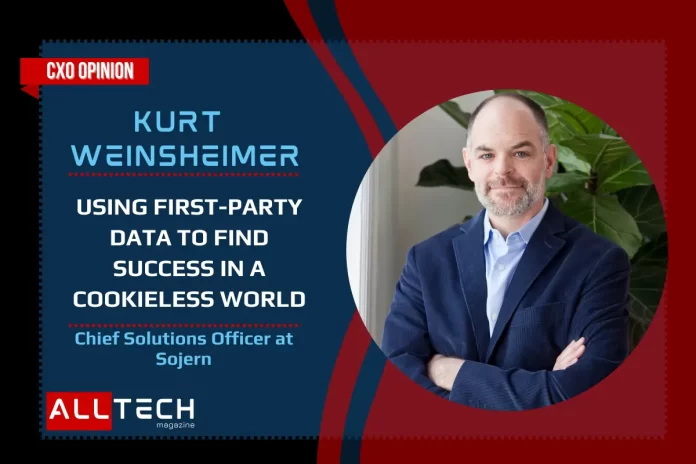In January 2020, Google announced that the company was going to phase out third-party cookies from its Chrome browser. Recent estimates show that approximately 66.14% of global internet users use Chrome as their browser, so marketers were–and still are–understandably concerned. Google recently pushed the third-party cookie demise out again to the second half of 2024, giving marketers more time to prepare. However, questions still remain: What’s the best way to replace third-party cookies? What can marketers do to ensure success in a cookieless world? One answer is clear – first-party data is one of the most important tools marketers can use both now and in the future to engage with travelers, create personalized experiences, and drive conversions.
Recently, Sojern released the findings of a 2022 survey titled, “How Hotel Brands are Using First-Party Data to Drive Revenue and Build Stronger Relationships”. While this survey focused on the travel industry, the results apply across industries. The study, conducted by Benchmark Research Partners with global hotel executives, gives critical insights into how hoteliers use first-party data–and why it’s important. According to the survey, 81% of hoteliers have seen a lift in revenue since implementing a first-party data strategy, while 57% have seen a lift in guest satisfaction. Marketers across industries can lift a page from the travel playbook and use first-party data to enrich the customer experience.
Here’s how to get started collecting first-party data, analyzing that information, and targeting potential customers to deliver the experience they want:
Collect
The first step toward success in a cookieless world is to start collecting first-party cookie data, such as first-party cookies and hashed emails. First-party cookies collect data from your web traffic without forcing users to log in for each visit, allowing you to track website behavior, language settings, and more. Unlike third-party cookies, first-party cookies will continue to be used since all the information is owned by you and comes straight from your audience.
Another key component of collecting first-party data is hashed emails. A hashed email uses an algorithm to convert an email into a unique, unrecognizable jumble of characters to identify and target customers online. You can prompt a login on your website so you have access to their email address. That email address is then turned into a pseudonymized string of characters that allows you to collect information and target that user without third-party cookies.
Collecting first-party data enables permission-based marketing, which puts people and relationships at the center of your marketing strategy and also complies with privacy rules and regulations such as GDPR. These regulations are constantly evolving and are in different stages around the world, and your marketing efforts must adhere to the privacy laws in the country where your traveler resides. Often, marketing partners can help you put guardrails on your marketing strategy so you can collect and use first-party data to build relationships and customer trust while complying with policies around the world.
Organize and analyze
Once you start collecting first-party data on your website, you can build customer profiles using a combination of other first-party data, including, purchases across channels, loyalty membership, and user-provided information such as demographics and stay preferences–all of which can help you learn about their interests and preferences and even begin to predict future behaviors. You can then frame your advertising strategies around that information and your predictions to deliver the right message at the right time–and increase conversions. Unlike third-party data, first-party data is not anonymous, making it far more powerful than third-party data. It also allows you to enable permission-based marketing, which means they have consent and have willingly given you their information.
After building your customer profiles, the next step is to analyze them in context with all of the other information you collect about your travelers. Together, hashed emails, first-party cookie IDs, and historical data, including CRM information, paint a complete picture of your customer, so it’s important to analyze all of your options. When you analyze information collected from hashed emails, first-party cookies, and historical booking data, you can target your travelers more effectively.
Target
The next step after you collect and analyze first-party data is to use it to deploy multi-channel campaigns. Multi-channel campaigns require you to have the right addressable and contextual targeting tactics in place. Addressable targeting is targeting people that are in your brand’s audience. They may still be anonymous users, but you know something about them. For example, you can retarget a traveler who once booked a facial at your spa or even shopped in your boutique. First-party cookies, hashed emails, and historical data are what will allow you to continue addressable targeting once the third-party cookie is gone.
Once you’ve dialed in your addressable advertising, you can expand contextual targeting efforts across channels to deliver ads with messaging that resonates with potential travelers. Contextual targeting looks at the category or keywords of the page being viewed by the user and the ad server serves ads that are highly relevant to the content on the site. For example, if someone is searching for activities in Cape Town, then they are likely interested in visiting South Africa. With that information, you can serve up relevant ads for hotel stays to help them with their search.
With first-party data, you can personalize the traveler experience across all touchpoints of their journey. For a hotel, this means you can have the right newspaper waiting for them upon arrival or even give them the option to request a towel or linen service via text. Or, if a family books a tour with your company, you can send them other child-friendly ideas that they can explore during their stay. With the right information at your fingertips, you can enrich their stay, build brand loyalty, and deploy successful marketing campaigns in a cookieless world.


